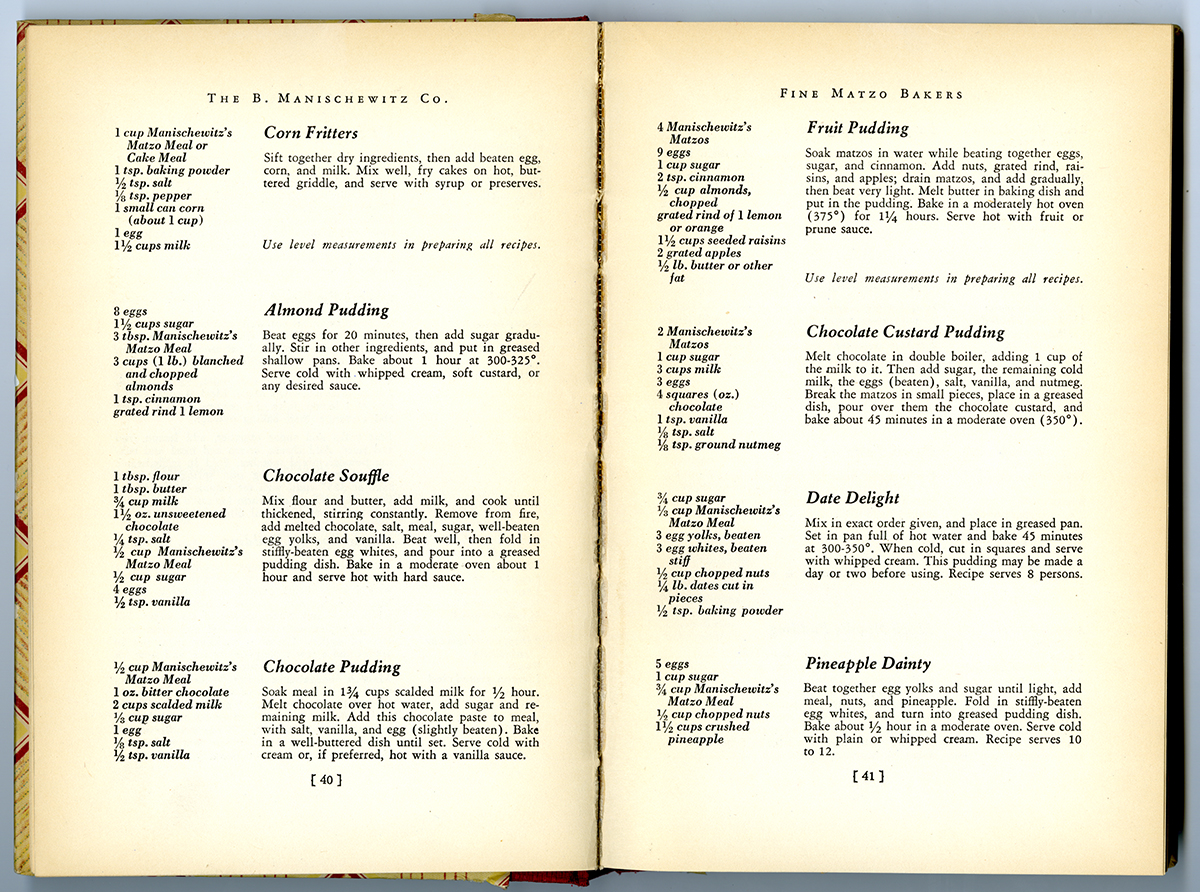By Noa Gutow-Ellis, Collections and Exhibitions Assistant
Eating, and the work that cooking it requires, is an intrinsic part of Jewish life. In her book Hungering for America: Italian, Irish, and Jewish Foodways in the Age of Migration, acclaimed historian Hasia Diner explained,
Judaism itself put food in the foreground, with its strict rules and commands to honor the holy days by eating well. If people had no food, as happened with frightening regularity, then the better-off Jews bore the responsibility of sharing something fine from their Sabbath and holiday tables with the hungry.
What might it mean for food to be intertwined with Jewish life? A focus on food can be a focus on ritual, like preparing dairy foods for Shavuot or braiding challah for Shabbat. A focus on food can render resilience: In the days before Passover, the Museum hosted a discussion on adapting our preparations, our cooking, and our eating with food journalist Liza Schoenfein, cookbook author Adeena Sussman, and former Editor-In-Chief of The Forward Jane Eisner. Here, a focus on food is a focus on stories of immigration like those Hasia Diner explores in Hungering for America.
The Museum of Jewish Heritage Collection contains cookbooks in a multitude of languages, published in a variety of countries. Today, we explore what three of these cookbooks can teach us about immigration, assimilation, and the development of American Jewish identity. The century spanning from the 1820s to the 1920s saw an influx in Jewish immigrants to the United States, as this interactive Library of Congress exhibition teaches.
Jewish immigrants arrived in various waves during this time, often dependent upon the country from which they came. Tensions arose between already-established German Jewish immigrants and the newly-arrived Eastern European Jewish immigrants whom some German Jews feared might cause a resurgence of antisemitism. As the Jewish Museum Milwaukee explains, settlement houses developed across the nation to help “Americanize” immigrants.
A leader of one of these settlement houses, Lizzie Black Kander, whom NPR called “the Matzo Ball Matriarch of American Jewish Food,” taught cooking classes to immigrants and published The Way to a Man’s Heart: The Settlement Cook Book as a way to fundraise for programming.

Offering more than just recipes, this book included illustrated advertisements from local merchants and information about American cultural norms and mores — particularly involving hospitality. It highlights the roles women played in the lives of families and societies at large. And, perhaps most importantly, it illuminates the labor of caring that women like Lizzie Black Kander engaged in as they sought to empower immigrant women with tools for success.
Florence Kreisler Greenbaum’s Jewish Cook Book was published in New York in 1926, shortly after the U.S. government began heavily limiting immigration into the United States through the Immigration Act of 1924.

The legislation came on the heels of high numbers of immigrants, including Jews fleeing Europe. This particular copy of the Jewish Cook Book was used by an immigrant who came to the United States through Ellis Island, Sara Orlov, after moving to New Jersey. Combining the ritual actions and laws of kashrut with recipes from countries throughout Europe, this cookbook speaks to a diversity in foods consumed, all united in that they adhered to laws of kashrut. Below, an inside look into the Jewish Cook Book features multiple recipes for kugel, a traditional Ashkenazi Jewish dish.

That this cookbook was printed at all has much to teach us. While Lizzie Black Kander’s Settlement Cook Book offered a how-to guide to empowerment and self-protection through knowledge of the dominant culture, Greenbaum’s Jewish Cook Book celebrates cultural mixing and the emergence of a new American Jewish identity. Within two decades, a shift occurred from a book teaching new immigrants how to Americanize to an American-published book featuring a compilation of Jewish recipes from around Europe. This shift was centered, not in the relatively small city of Milwaukee, but in the massively multicultural metropolis of New York City. There, American Jews began to emerge as an identity group, one that could assimilate and still hold onto unique cultural markers — like kugel!
In addition to recipes from around Europe, the Museum has cookbooks that highlight the history of Jewish language traditions in the United States. Published in 1930 by the Manischewitz Company, Tempting Kosher Dishes offered a range of recipes in two languages: English and Yiddish. In the 1930s and 1940s, Jewish and non-Jewish food companies alike produced similar bilingual marketing materials. That American Jews were speaking Yiddish widely enough for companies to produce substantial Yiddish marketing materials is evidence of both the development of immigrant communities and the fact that American Jews were becoming an identity group significant enough to warrant tailored marketing.

The photographs below shows interior pages of Tempting Kosher Dishes, including a Jewish calendar, highlighting the connection between Jewish ritual and food consumption.


Taken together, these cookbooks show that stories of Jewish communities and the food they eat in America are often rooted in stories of immigration, assimilation, and holding onto — or reinventing — traditions, while forging new communities and ways of life. To learn about the immigration stories of Museum staff, click here.